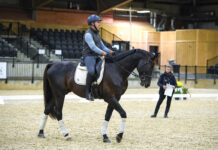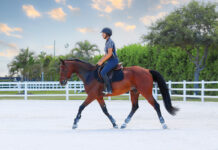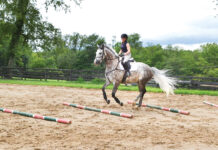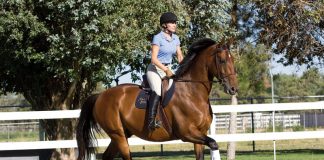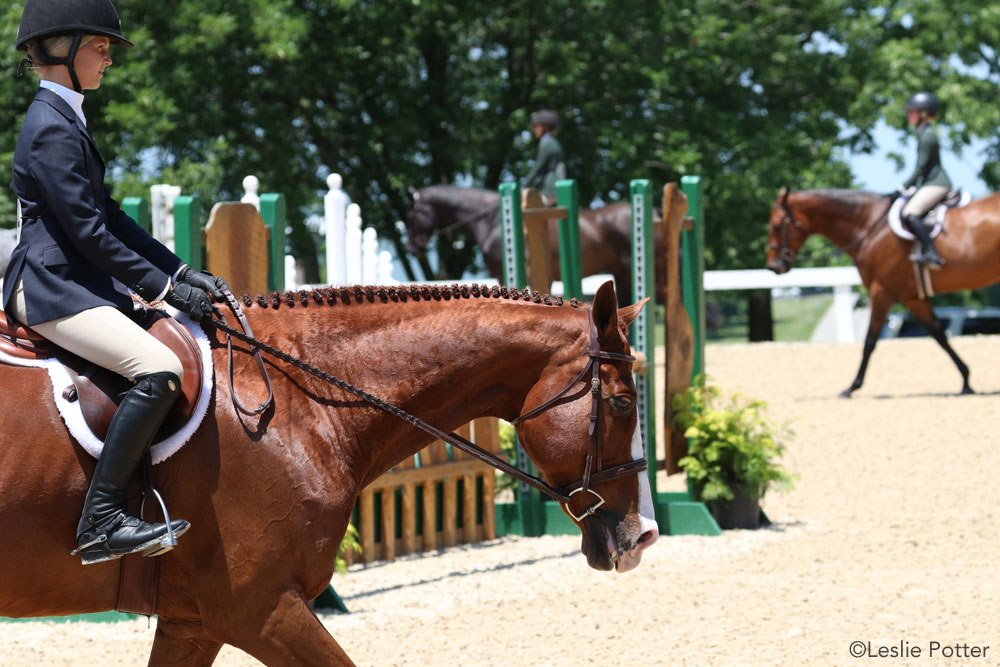
1. Tack
You’ll be penalized for “unconventional tack” so make sure your pony is wearing the correct gear. Your saddle, bridle and girth should be brown and your pony should wear a snaffle bit. Your pad should be white and saddle-shaped. Your pony shouldn’t wear boots, bandages, a martingale or a breastplate. Safety stirrups with rubber bands are fine. Just before you enter the arena, check that your reins and stirrup leathers aren’t twisted and that leather straps are securely in their keepers.
2. Clothes
You should wear beige breeches and tall black boots or jodhpurs, garters and brown or black short boots, a dark show coat, black helmet and black gloves. If your pony is a bit pokey, carry a dark crop. If you’ve got long hair, make it neat and tidy with a hairnet.
3. Braid Up
At bigger shows, braid your pony’s mane and tail. He should also be spotless! Feathers and whiskers should be trimmed. Ask a pal to dust off your boots and to paint hoof oil on your pony’s hooves just before you enter the arena.
4. Avoid Traffic Jams
When you enter the arena, keep plenty of space between you and the horse in front of you. Don’t get into a traffic jam. As the class continues, be aware of where the other competitors are. If you get too close to another pony, circle or cut across the arena when the judge isn’t looking in your direction. You want to stand out, not be part of a crowd where the judge can’t see you properly. Also, try not to get caught on the rail with another pony on the inside hiding you from the judge.
5. Your Position
Your position is very important in an equitation class. Sit up straight, but don’t be stiff. If you feel nervous, take a few deep breaths and try to relax. Sit lightly in the saddle. At the walk, trot and canter your body should be slightly in front of the vertical. Get into two point position for the hand gallop.
Keep your eyes up and straight ahead when you’re riding down the long side of the arena, and turn your head slightly when you head round a corner.
Your hands should be just over and slightly in front of your pony’s withers. They should be far enough apart that you can just touch your thumbs together. Your hands and knuckles should be slightly tilted inside the vertical—about 30 degrees. There should be a direct line from your elbow to your pony’s mouth and your hands should follow the movement of your horse’s head.
Your legs should rest on your pony’s sides just at or slightly behind the girth. Push your heels down so your legs don’t move backward and forward at the canter. One of the first things a judge will notice is your swinging leg.
6. Your Pony
Even though the judge isn’t judging your pony, she’ll notice the way he moves and behaves. If he bucks or jerks the reins out of your hands, you’re not going to win a blue ribbon. Your pony should be forward going with energy. He should take long, loose strides—not short, choppy steps. You should have a light contact on the reins– not loopy long reins—and your pony should accept the bit contact without pulling or fussing.
7. Fix Mistakes Quickly
You’ll be penalized if the judge spots you on the incorrect diagonal or canter lead, pay attention the entire time you’re in the arena. If you start off on the incorrect diagonal, change it instantly by sitting two beats. If your pony’s on the wrong lead, don’t panic. Just slow down to the trot and ask for the lead again a little more carefully. Don’t stay on the wrong lead and pretend nothing’s wrong! The easiest place to ask for the canter is in a corner, so try to be near a corner of the arena when you think the judge is going to ask for the canter.
8. Transition Time
When the judge asks you to trot—trot! Your transitions should be smooth and quick. The judge will definitely notice if you have to kick your pony for 30 seconds before he moves up a gear. Practice transitions at home until your pony responds to your cues immediately. Also, make sure your horse stands quietly when you halt. Fidgeting at the halt will keep you out of the ribbons.
9. Drop Your Stirrups
Don’t be surprised if the judge asks you to drop your stirrups in the middle of a class. He or she will give you time to cross your stirrups over your horse’s neck, so don’t leave them hanging down so they bang on your horse’s sides. You’ll probably just be asked to do sitting and posting trot without stirrups and you won’t have to do it for long. Practice riding without stirrups at home so you’ll be prepared for this torture during the class!
10. Test Time
If the judge likes the look of you, he or she may ask you to join several other riders and perform a test. The test may include halting squarely and backing up (the judge will tell you how many steps to back), a turn on the forehand, a simple change of lead, a figure-eight at the trot and/or canter (you might be asked to do a flying change of lead at a rated show), dismounting and mounting and hand galloping. Master all of these movements at home with your trainer before you enter an equitation on the flat class. You don’t want to be attempting a new movement in the show arena!

